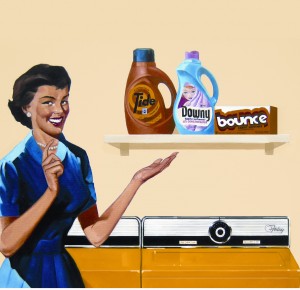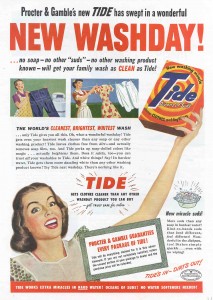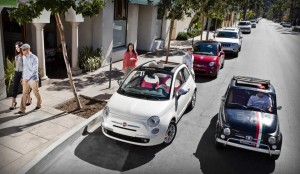As you browse through your local store shelves, you may discover some old brands made new by being made old again. So how does that work? Doritos, Pepsi products and long time soap brands such as Tide and Bounce are bringing back the branding of their former selves. http://multivu.prnewswire.com/mnr/pg/47792/.

Branding attempts to shape the image of a product or service. It has to do with the way the consumer perceives the product or service. Some see this retro marketing as nothing more than an interest in nostalgia, but I disagree. Retro branding is another way to build again on what is already a strong brand. In our down-turned economy since at least 2008, people are making harder choices when it comes to purchasing decisions. By reminding consumers that a brand has been around since the last depression, the real message is the brand will be here through this economy too. http://online.wsj.com/article/SB10001424052702304066504576343202190467300.html. These products are also trying to convey an image of quality. Consumers want quality which translates to value; consequently, browsing turns to buying.

Retro branding is one step in the advertising spiral to remind people what the brand oncewas and that the same quality product still exists after all these years. Many products have enjoyed great long-term success. Renewed retro branding reminds everyone of why a brand became so successful in the first place. An advertising professor of mine back at the Newhouse School at Syracuse University stated emphatically that advertising and marketing efforts can get someone to buy your product once, but it is real work to get repeat buyers. These brands are not just about the packaging, but also the design associated with the product as well. We see this in car branding. Both mini cooper and fiat have new cars that hold true to their original design in order to create a perception about their brand. Here are two brands that have a retro style that is unique to their brand and make these cars stand out among all the cookie-cutter cars on the street that have no personality. The mini cooper and the fiat 500 do not need their respective logos attached to them, because their design is part of their brand and you recognize these cars from a distance.

Famous brands have achieved a high level of notoriety because of the extensive advertising and marketing efforts of the brand owner. That usually translates into dollars. Those millions of dollars are worth something in court as well. Take a look at Quality Inns Int’l, Inc. v. McDonald’s Corp., 695 F.Supp. 198 (D. Md. 1988). In that case, the court recognized McDonald’s spent millions of dollars on its famous mark, the word “McDonald’s” and the associated golden arches. The value and good-will in the community created by McDonald’s with their well known brand was something important. In this case there was a hotel chain trying to capitalize on McDonald’s good will. Courts recognize the value that comes with investing money to build a brand. https://www2.bc.edu/~liujr/courses/tm08s/quality.doc.
Advertising and marketing efforts of a company create the brand which in turn shapes the perception and image of a product or service. By utilizing tools such as trademark law, advertising law, first amendment rights and other areas of communications law, companies can and do achieve brand protection. A good brand strategy team should include a brand protection attorney from the first stage of brand development; a creative attorney who can be a part of the marketing strategy at all levels. Imagine creating an awesome product that quickly gets a lot of interest from consumers, but then goes viral and everyone has to have your product. People don’t want knock offs, they want the original article. Nothing creates an image of quality like the original brand, the original manufacturer, the original version with a connection to the creator. Maybe that is why I am hanging on to my old Doc Marten’s that say “Made in England.” Try to find a pair, you will pay a premium. For some reason, I am convinced that the “Made in England” Doc’s are better because that is where they were originally created and made; so, they must be a superior quality product which fit better, wear better and are…. well…. just better. Really…whether it is true or not, people behave in this manner. Branding is everything.
The Problem
If you have decided to create a product of your own, you might decide to give your company a name that represents you. Your workmanship. Your dedication. Your craft. After a lot of thinking, brain-storming and debate, you decide to call your product “Fred’s Lamp Shades.” Your lamp shades are a hit and they are sold all over the area where you make them. Suddenly you get calls from all over the country to place orders for your lamp shades. The business is growing and deliveries are being made all over the country. The problem is that there has been a small company in Iowa using the same name as yours. You are totally bummed because you have spent a lot of money on advertising and marketing your product under the brand “Fred’s Lamp Shades.” No problem, you just come up with another name. But now people do not know your product by your new name, they only knew it by the old name. Plus, some people think that the other producer is the real “Fred’s Lamp Shades” and are now actually creating the product that you made so popular. And a third company claims they are the “Original Fred’s Lamp Shades.” To make matters worse, you get a cease-and-desist letter from a company telling you to stop using that mark and that they have been making lamp shades for about a hundred years under that name. So, what do you do?
If your branding attorney was with you from the inception of your product’s branding efforts, you could have saved yourself a lot of expense and agony. Even if you only have a limited budget for legal representation, it might be the best money you could spend. As they say (whoever they are) an ounce of prevention is worth a pounding from the other side. Not having a branding plan or going with a company that sells forms on the internet is not true legal advice. Yes, you can fill out a form bought from a company that sells forms, which may even be free from the Secretary of State’s website in your state. Seems easy enough, so you create a Corporation, file your Trademark and get your Will knocked out all at once. The problem is the form will not be sitting with the marketing team at the next creative meeting discussing the new product brand. Your brand must have its own identity; an identity that can represent the whole of a product or a company. A brand must be safe to inject all your marketing budget into without worrying that someone else is already using that brand, that mark or that design. From a few thousand dollars to millions, marketing dollars should be safely directed. Either way, it is a big piece of the budget pie that gets tossed into a bin of discarded cell phones if some other entity or person has already acquired the mark. You need between-the-lines guidance that cannot come from an internet web site. A branding attorney should be a part of the process and prevent a new brand from making fatal errors that could have been easily avoided at the “holy cow” stage of the product. There are many things that can go wrong at the early stage of a brand. So, rather than create a dry dissertation of law, I have a few suggestions that should be considered before just picking a name like “Fred’s Lamp Shades” or “Ray’s Pizza” for your brand.
Considerations for your Brand Strategy
- Consult a brand protection attorney. Not just because I believe in getting your brand protection attorney involved early in the process, but because four years from now it will cost you a lot more to defend a lawsuit. In order to defend a legal action, it can take a lot of time to discover what happened, develop a defense or alternative action. That time can be expensive. Plus, don’t forget the expense of rebuilding your website after you take it down for several months while you go through these steps to create a new brand. You were smart enough to create mobile apps for online shoppers to click-drag-drop-and-deliver, but now your site needs to come down while the injunction is in place and your brand is reinvented. I am sure those shoppers will be there when you come back online, right? Not to mention all the other marketing efforts already paid for, it must be undone and you get to start all over. I’m just saying —- it is expensive to undo things. Better to have guidance up front.
- Create a budget. Well, someone has to pay for the effort. Even if your budget is small, sit down with your brand protection attorney and come up with a reasonable budget and take baby steps. In the early stages you might just need a simple plan to carry it all until things take off. Having someone in place to help you with the small items early on will be advantageous when the company begins to grow. A larger company should view their brand protection attorney as giving proactive legal advice as part of a team. Advice that counsels your company in the things you can and should do to be competitive. This is counter-intuitive to some, because we ofen see legal counsel as performing a defensive role and telling us what not to do.
- Have a strategy. Sounds basic, but how can stay focused without a clearly defined stategy? Decide on a strategy for your product or service and then build a brand that fits into that strategy. You are creating a brand that will be around for the long haul. Here is where you have a meeting with your in-house marketing person, a consultant or an outside advertising agency and of course, your brand protection attorney. Without a long-term plan, you might find that you have to “fix” your strategy as you grow. As an example, Starbucks recently removed the word “coffee” from their logo, because they want to expand into different areas that are presumably not just coffee. Not that Starbucks sees that as a mistake, just a deviation on their strategy. Starbucks can afford to make this adjustment, but this deviation for one company could be devistation to another company with limited resources. http://seattletimes.nwsource.com/html/businesstechnology/2014436565_starbucks09.html. Starbucks is a relatively young company, but it is a company that has been around the advertising spiral mentioned earlier, so they probably already have a room full of attorneys giving them advice on how to proactively build their brand. http://www.starbucks.com/preview. On planet earth, the realities of your company may not allow for a complete rebranding down the road. Your brand should not put you into a hole you cannot afford to dig out of. Worse, you don’t want to be forced to completely rebrand because you are infringing on another more senior brand. A brand protection attorney can help you by making sure —ahead of time— that you are clear to move forward and start building a brand.
- Focus. All that money you just set aside for your branding? Well… don’t get silly spending your budget getting a trademark for each style of chair you create. Focus on the main brand until you get big enough to create smaller brands. Refer back to your well defined strategy and create the brand that reflects your product’s values. Part of the retro trend in brand advertising seems to be to eliminate the clutter surrounding today’s marketing by keeping the message simple and clear. My whole career I have heard people say “Keep it Simple!” but as soon as they get their hands on an advertising campaign it quickly becomes complicated and crammed full of every messege remotely related to the purpose of the project. The messege gets lost in all the noise and clutter. Keep it simple and stay focused.
- The power position. This is the place you want to be when you put your brand strategy to work. You want to own your brand and everything relating to your product or service. People will recognize your brand and know that your company is the source of its creation. Your brand obtains a firm footing with a position not easily challenged; in court or in the mind of the consumer. The power position is where you can control your brand and use it in any way necessary to grow your company. If your branding is done well, it will be you writing letters to other people and companies telling them to stop using your brand.
Getting to the power position with your brand might seem like a daunting task, but it doesn’t have to be. You simply want others to know that when they buy a product with your branding that it came from you. No confusion. Your brand represents all of the money you have invested in creating your product from your brick and mortar buildings to your advertising and online presence. Getting the guidance and advice early-on will allow you to build your brand so that, as an owner of your brand, you may one day enjoy the power and longevity similar to other well known brands. It might be your grandchildren wanting to bring back the original design and mark of the brand you create today.
The take away here is that creating something intangible as your brand is a very important and valuable part of your business plan. Not paying attention to it could cost you dearly down the road in the form of expensive legal fees, litigation or being forced to rebrand altogether. While some companies can afford to re-brand or pay for expensive legal fees and/or litigation, many companies cannot absorb that expense. The point here is that it may be a cost effective strategy for your business to consult with an attorney that understands the big picture of creating and protecting your brand in the big picture of trademark law, advertising law, media law, communications law and corporate law among others. It is easier to address this issues while you are still creating your brand rather than try to fix it or defend it later.
Disclaimer: The discussion here is commentary by the author and does not constitute legal advice. Mr. DeGeorge is licensed to practice in the state of Colorado and Federal District for the District of Colorado.
Copyright 2011- DeGeorge Law LLC www.degeorgelaw.com
